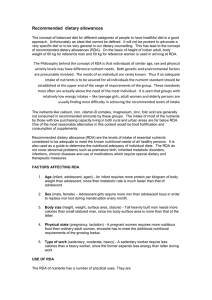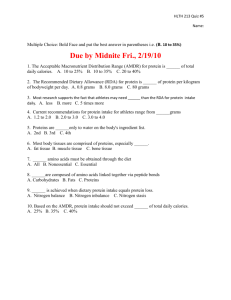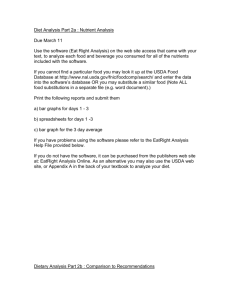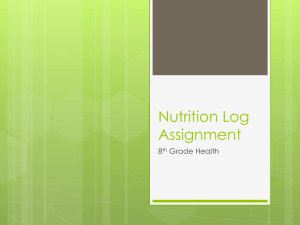The food table or board
advertisement
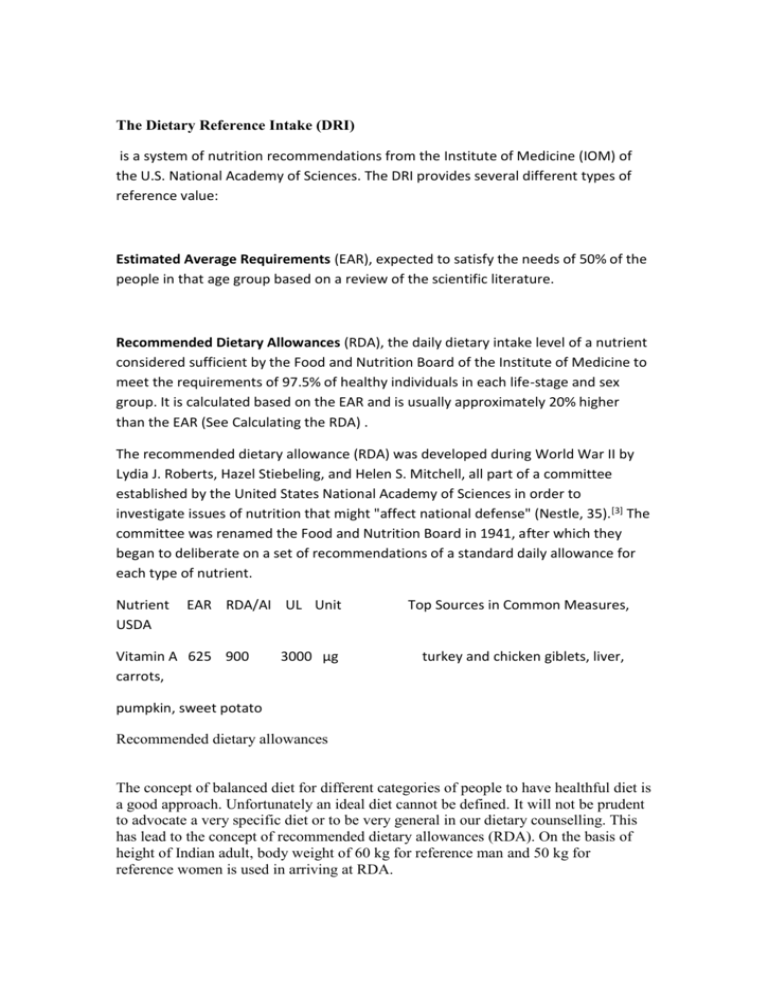
The Dietary Reference Intake (DRI) is a system of nutrition recommendations from the Institute of Medicine (IOM) of the U.S. National Academy of Sciences. The DRI provides several different types of reference value: Estimated Average Requirements (EAR), expected to satisfy the needs of 50% of the people in that age group based on a review of the scientific literature. Recommended Dietary Allowances (RDA), the daily dietary intake level of a nutrient considered sufficient by the Food and Nutrition Board of the Institute of Medicine to meet the requirements of 97.5% of healthy individuals in each life-stage and sex group. It is calculated based on the EAR and is usually approximately 20% higher than the EAR (See Calculating the RDA) . The recommended dietary allowance (RDA) was developed during World War II by Lydia J. Roberts, Hazel Stiebeling, and Helen S. Mitchell, all part of a committee established by the United States National Academy of Sciences in order to investigate issues of nutrition that might "affect national defense" (Nestle, 35).[3] The committee was renamed the Food and Nutrition Board in 1941, after which they began to deliberate on a set of recommendations of a standard daily allowance for each type of nutrient. Nutrient USDA EAR RDA/AI UL Unit Vitamin A 625 900 carrots, 3000 µg Top Sources in Common Measures, turkey and chicken giblets, liver, pumpkin, sweet potato Recommended dietary allowances The concept of balanced diet for different categories of people to have healthful diet is a good approach. Unfortunately an ideal diet cannot be defined. It will not be prudent to advocate a very specific diet or to be very general in our dietary counselling. This has lead to the concept of recommended dietary allowances (RDA). On the basis of height of Indian adult, body weight of 60 kg for reference man and 50 kg for reference women is used in arriving at RDA. The Philosophy behind the concept of RDA is that individuals of similar age, sex and physical activity levels may have difference nutrient needs. Both genetic and environmental factors are presumably involved. The needs of an individual are rarely known. Thus if an adequate intake of nutrients is to be assured for all individuals the nutrient standard should be established at the upper end of the range of requirements of the group. These standards most often are actually above the need of the most individual. It is seen that groups with relatively low energy intakes – like teenage girls, adult women and elderly persons are usually finding most difficulty in achieving the recommended levels of intake The nutrients like calcium, iron, vitamin-B complex, magnesium, zinc, folic acid are generally not consumed in recommended amounts by these groups. The intake of most of the nutrients by those with low purchasing capacity living in both rural and urban areas are far below RDA. One of the most reasonable alternative in this context would be food fortification and consumption of supplements. Recommended dietary allowance (RDA) are the levels of intake of essential nutrients considered to be adequate to meet the known nutritional needs of all healthy persons. It is also used as a guide to determine the nutritional adequacy of individual diets. The RDA do not cover abnormal problems such as premature birth, inherited metabolic disorders, infections, chronic diseases and use of medications which require special dietary and therapeutic measures. The Food and Nutrition Board addresses issues of safety, quality, and adequacy of the food supply; establishes principles and guidelines of adequate dietary intake; and renders authoritative judgments on the relationships among food intake, nutrition, and health. DRI is the general term for a set of reference values used to plan and assess nutrient intakes of healthy people. These values, which vary by age and gender, include: Recommended Dietary Allowance (RDA): average daily level of intake sufficient to meet the nutrient requirements of nearly all (97%-98%) healthy people. Adequate Intake (AI): established when evidence is insufficient to develop an RDA and is set at a level assumed to ensure nutritional adequacy. Tolerable Upper Intake Level (UL): maximum daily intake unlikely to cause adverse health effects. FACTORS AFFECTING RDA: 1. Age (infant, adolescent, aged) - An infant requires more protein per kilogram of body weight than adolescent, since their metabolic rate is much faster than that of adolescent. 2. Sex (male, female) – Adolescent girls require more iron than adolescent boys in order to replace iron lost during menstruation every month. 3. Body size (height, weight, surface area, stature) - Tall heavily built man needs more calories than small statured man, since his body surface area is more than that of the latter. 4. Physical state (pregnancy, lactation) - A pregnant women requires more nutritious food than ordinary adult woman, since she has to meet the additional nutritional requirements of the growing foetus. 5. Type of work (sedentary, moderate, heavy) - A sedentary worker require less calories than a heavy worker, since the former expends less energy than latter during work USE OF RDA: The RDA of nutrients has a number of practical uses. They are: 1. To enable government to predict food needs of the population 2. To provide basis for food distribution quota 3. To guide agricultural planning policy 4. To guide policy of food export and import. 5. To guide planning of nutritionally adequate diets of inmates of larges catering establishment such as hospitals, hostels, hostels, army canteen, etc., 6. To evaluate the findings of food consumption surveys of various population groups. 7. To evaluate the adequacy of food supplies in relation to nutritional needs 8. To develop and evaluate new products developed by the food industry. 9. To establish guidelines for labelling of food from the nutritional standpoint 10. To develop nutrition education programmes. The food table or board (food consumption pattern) Included four major action steps for the American public: 1. Reduce the incidence and prevalence of overweight and obesity of the US population by reducing overall calorie intake and increasing physical activity. 2. Shift food intake patterns to a diet that emphasizes vegetables, cooked dry beans and peas, fruits, whole grains, nuts, and seeds. In addition, increase the intake of seafood and fat-free and low-fat milk and milk products and consume only moderate amounts of lean meats, poultry, and eggs. 3. Significantly reduce intake of foods containing added sugars and solid fats because these dietary components contribute excess calories and few, if any, nutrients. In addition, reduce sodium intake and lower intake of refined grains that are coupled with added sugar, solid fat, and sodium. 4. Meet the 2008 Physical Activity Guidelines for Americans In addition: 1. Eating behaviors were addressed (e.g., breakfast, snacking, fast food) and the association of screen time with increased body weight was assessed. 2. Recommendations to increase consumption of plant foods (vegetables, cooked dry beans and peas, fruits, whole grains and nuts and seeds) were included. 3. Seafood consumption of 8 oz (two servings) per week was encouraged. The Report noted that the benefits of consuming seafood far outweigh the risks, even for pregnant women.
